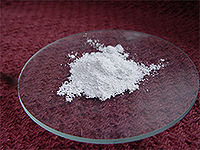Strontium carbonate
 |
|
| Names | |
|---|---|
|
IUPAC name
Strontium carbonate
|
|
| Other names | |
| Identifiers | |
|
1633-05-2 |
|
| 3D model (Jmol) | Interactive image |
| ChemSpider |
14666 |
| ECHA InfoCard | 100.015.131 |
| EC Number | 216-643-7 |
| PubChem | 15407 |
| RTECS number | WK8305000 |
| UNII |
41YPU4MMCA |
|
|
|
|
| Properties | |
| SrCO3 | |
| Molar mass | 147.63 g/mol |
| Appearance | White powder |
| Odor | Odorless |
| Density | 3.74 g/cm3 |
| Melting point | 1,494 °C (2,721 °F; 1,767 K) (decomposes) |
| 0.0011 g/100 mL (18 °C) 0.065 g/100 mL (100 °C) |
|
| Solubility | soluble in ammonium chloride slightly soluble in ammonia |
| −47.0·10−6 cm3/mol | |
|
Refractive index (nD)
|
1.518 |
| Structure | |
| rhombic | |
| Hazards | |
| Safety data sheet | External MSDS data |
| NFPA 704 | |
| Flash point | Non-flammable |
| Related compounds | |
|
Other cations
|
Magnesium carbonate Calcium carbonate Barium carbonate |
|
Except where otherwise noted, data are given for materials in their standard state (at 25 °C [77 °F], 100 kPa).
|
|
|
|
|
| Infobox references | |
Strontium carbonate (SrCO3) is the carbonate salt of strontium that has the appearance of a white or grey powder. It occurs in nature as the mineral strontianite.
Strontium carbonate is a white, odorless, tasteless powder. Being a carbonate, it is a weak base and therefore is reactive with acids. It is otherwise stable and safe to work with. It is practically insoluble in water (1 part in 100,000). The solubility is increased significantly if the water is saturated with carbon dioxide, to 1 part in 1,000. It is soluble in dilute acids.
Other than the natural occurrence as a mineral, strontium carbonate is prepared synthetically in one of two manners. First of which is from naturally occurring celestine also known as strontium sulfate (SrSO4) or by using soluble strontium salts by the reaction in solution with a soluble carbonate salt (usually sodium or ammonium carbonates). For example if sodium carbonate was used in solution with strontium nitrate:
Sr(NO3)2(aq) + Na2CO3(aq) → SrCO3(s) + 2 NaNO3(aq).
The most common use is as an inexpensive colorant in fireworks. Strontium and its salts emit a brilliant red color in flame. Unlike other strontium salts, the carbonate salt is generally preferred because of its cost and the fact that it is not hygroscopic. Its ability to neutralize acid is also very helpful in pyrotechnics. Another similar application is in road flares.
Strontium carbonate is used for electronic applications. It is used for manufacturing CTV to absorb electrons resulting from the cathode.
It is used in the preparation of iridescent glass, luminous paints, strontium oxide or strontium salts and in refining sugar and certain drugs.
...
Wikipedia

